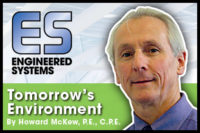This month, the focus is on high-performance health care, and so it got me thinking about IAQ and infection control (IC) within hospitals. As a rule, the facility management department oversees IAQ, and a group from the medical staff oversees IC. It’s no secret that thousands of patients enter hospitals each year and while in the hospital are exposed to deadly viruses and/or diseases. In turn, many become sick from these infectious viruses, etc., and thousands will die each year from the exposure while they were being treated for another medical issue.
Now, I know a lot of health care institutions contract out many, if not all, of their facility management (a.k.a. support services). So why not outsource IC management? As crazy as this may seem, just look back over the past 20 to 30 years, and facility management has been able to get control of IAQ to the point where you don’t read about sick buildings any more. So why not have the in-house or outside facility management group take over the management of IC? Think about it — building managers would love to elevate their presence if they are in charge of infection control and the financial impact it has on a hospital.
Personal hygiene is critical to minimizing IC, but the IC medical staff just isn’t enforcing IC policy and procedure (P&P). If they were, then IC would not be the concern that it is. Providing hygienic conditioning of medical equipment and hospital equipment is achieved by the non-medical support service group(s). HVAC systems, operating to specific positive and negative space pressure, contribute to a healthy building where the instruments and equipment are cleaned. Housekeeping of central sterile supply, laundry, and kitchen and kitchen food preparation are hygienic tasks managed by support services. That said, maybe high-performance health care facilities should break the mold on standard management approach to IC and outsource IC to support services experienced in managing health care responsibilities.
Medical personnel’s primary responsibility is to treat patients, not to manage IC P&P. As a result, health care facilities continue to struggle with eliminating hospital acquired infections. Even with outside financial penalties hanging over the IC department, high-performance health care IC is not being achieved. It is time for a change, for the sake of all those people entering into a health care facility.
So here is my suggestion for establishing an IC support service within the facility management organization.
-
Create a “solution team” to brainstorm how IC management and the IC P&P could be implemented using personnel and CMMS within the facility management organization.
-
Restructure the job description of the IC manager based on specific qualification and experience to manage people and P&P.
-
This team would remain intact as a 3rd-party oversight committee, monitoring and meeting quarterly with the facility support IC group to continuously improve the IC process.
-
Create an organization chart to shape the IC group while limiting the staff to a select few and drawing upon other support service groups (e.g., HVAC department) to implement the IC responsibilities. Just like the HVAC O&M group may choose to manage filter replacements but contract out the maintenance of their chillers and boilers, this IC support service group would contract out the IC P&P compliance (maintenance of a patient room, etc.).
-
Create an IC budget drawing upon the previous IC department budget that was managed by the medical staff. Redistribute this budget based on a new organization chart that includes an experienced manager, administrative assistance, in-house and/or outsource support service groups, and an outside IC health care specialist, along with other consultants (e.g., HVAC health care design engineer) who would be on retainer and provide 3rd-party advice/guidance.
This approach is an abbreviated discussion of finding a better way to improve IC within high-performance facilities, but it is also based on time-tested quality control methods — methods used for problemsolving within the public sector to continuously improve a process, or to troubleshoot a chronic problem (e.g., safety associated within a pharmaceutical medicine production facility). In the real world, I’m pretty sure hospitals are too bureaucratic to give up IC management, but I’m pretty sure this approach will catch the public sector building management’s interest as a cost-effective solution to IC. ES





